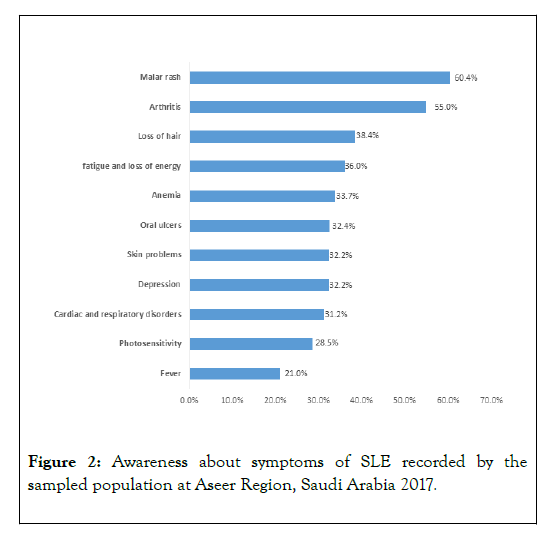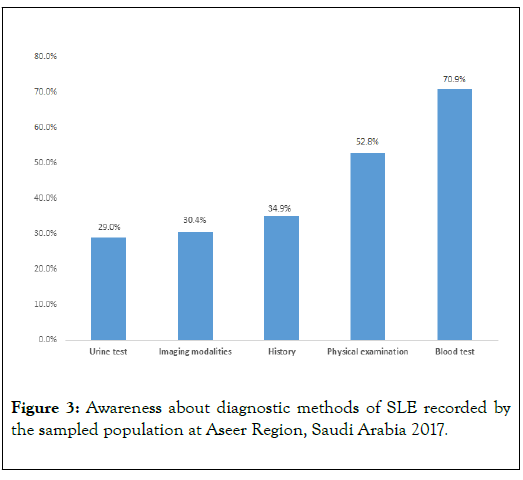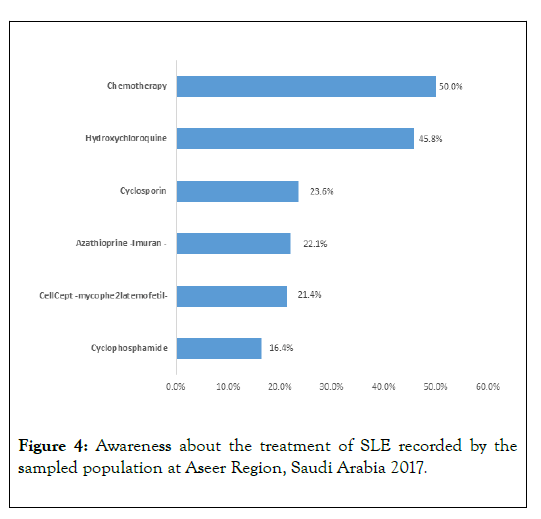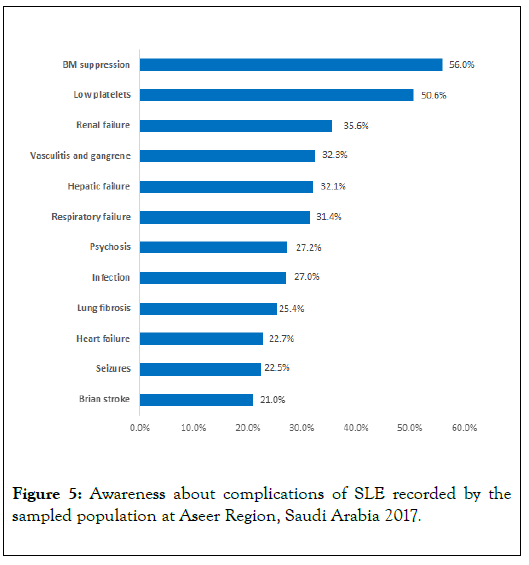Rheumatology: Current Research
Open Access
ISSN: 2161-1149 (Printed)
ISSN: 2161-1149 (Printed)
Research Article - (2020)Volume 10, Issue 2
Introduction: Systemic lupus erythematosus (SLE)), or lupus, is an autoimmune disease in which a person's immune system attacks various organs or cells of the body, causing damage and dysfunction. It is one of the worldwide autoimmune disorder that has a significant mortality and morbidity. Objective: The current study aims to assess knowledge regarding SLE among the general population in Abha city, Aseer region, KSA.
Methodology: Descriptive cross-sectional study was used. Sample: A total of 405 individuals were selected using a simple sampling technique. Selected participant was interviewed using a questionnaire which consisted of many parts dealing with all aspects of SLE (risk factors, diagnosis, management, and prognosis). Data were entered and analyzed by using SPSS. Relevant statistical tests were used according and considered significant if values were less than 5%
Results: A total of 405 individuals were involved in this study. Age ranged between 18-55 years, 58% were females. More than one third ( 39.3%) had good knowledge of SLE particularly general and treatment aspects (54%,42%) respectively. The higher knowledge level about SLE was Found among younger participants (below 35 years) than among older (46.9% vs. 30.3%) with statistical significance (P<0.05) which is clearly showed in our results
Conclusion and recommendations: This study revealed that the knowledge about SLE among participants was inadequate particularly among less educated, there are so many misconceptions about essential information of these serious diseases which need public health education using different methods including new social media. The comprehensive national study is suggested to explore the knowledge about SLE
Systemic lupus erythematosus; Awareness; Knowledge; General population; Aseer region; Saudi Arabia
Systemic lupus erythematosus (SLE), or lupus, is an autoimmune disease in which a person's immune system attacks various organs or cells of the body, causing damage and dysfunction [1]. Lupus is known as a multisystem disease because it can affect many different tissues and organs in the body. Some patients with lupus have very mild disease, which can be treated with simple medications, whereas others can have serious, lifethreatening [1,2].
While lupus is a chronic illness, it is characterized by periods when the disease activity is minimal or absent (remission) and when it is active (relapse or flare). The prognosis for patients with lupus today is much better than years ago because of greater awareness and more accurate tests leading to earlier diagnosis and treatment as well as more effective and safer medications and monitoring methods [3].
Systemic lupus erythematosus (SLE) is one of the worldwide autoimmune disorder that has a significant mortality and morbidity [4]. It is a persistent long term disorder which is more common in women [5,6]. The underlying cause of autoimmune diseases is not fully understood, but the hidden process in SLE is that the immune system mistakenly attacks healthy tissue by using complexes or cytotoxic antibodies which impact on body organs [4,7].
Therefore, SLE has unevenness at the onset that making correct and early diagnosis is challenging [8]. SLE is one of several diseases known as "the great imitator" because it often mimics or is mistaken for other illnesses [9].
Prognosis is typically worse for men and children than for women; however, if symptoms are present after age 60, the disease tends to run a more benign course. Early mortality, within 5 years, is due to organ failure or overwhelming infections, both of which can be altered by early diagnosis and treatment.
The mortality risk is fivefold when compared to the normal population in the late stages, which can be attributed to cardiovascular disease from accelerated atherosclerosis, the leading cause of death for people with SLE [10-12].
Patients and their caregivers often find that they must learn to identify and care for their physical symptoms quickly in order to manage their disease more effectively. This ability to monitor one's disease is often difficult as symptoms expression and severity is extremely unpredictable. This may help in early diagnosis and to minimize its complications and severity.
The investigators noticed that the awareness among patients and their first relatives was deficient despite that this disease is chronic with serious consequences. To our update search we could not find any research exploring these topics among the general population.
The aim of this study was to explore the knowledge regarding SLE among the general population in Abha city, Aseer region, KSA.
This study was conducted in Abha city, Aseer region, KSA during 2018-2019 after obtaining approval from the research ethical committee 11-8-2017. To achieve the objectives of this study an intensive literature review was made to construct a relevant questionnaire. The questionnaire consisted of the following parts (demographic data, general knowledge, risk factors, diagnostic methods, therapies, and complication).
The questionnaire was administered under the supervision of three of the investigators to represent a sample of adults attending Malls, gardens, and markets during the study period. Questions were given one score for the correct answer and zero for incorrect answers. The total score was changed to a percentage. Those who had 60% or greater were considered to have good knowledge while those who got less than 60% were classified to have poor knowledge of SLE. Data were coded, entered and analyzed using SPSS version22. P-value less than 0.05
The total participants in this study were 405 individuals with a mean age of 28.8(18-55) years. About 2/3 were females (66.7% and 70% were married Most of the participants were educate (93%) Table 1.
| Socio-Demographic data | No (405) | % | |
|---|---|---|---|
| Age in years | 18-24 | 113 | 27.90% |
| 25-35 | 140 | 34.60% | |
| 36+ | 152 | 37.50% | |
| Gender | Male | 135 | 33.30% |
| Female | 270 | 66.70% | |
| Marital status | Married | 286 | 70.60% |
| Unmarried | 119 | 29.40% | |
| Nationality | Saudi | 359 | 88.60% |
| Non-Saudi | 46 | 11.40% | |
| Level of education | Illiterate/ basic education | 26 | 6.40% |
| Intermediate school | 33 | 8.10% | |
| Secondary school | 93 | 23.00% | |
| University | 221 | 54.60% | |
| Postgraduate | 32 | 7.90% | |
| Profession | Medical professionals | 63 | 15.60% |
| Medical students | 20 | 4.90% | |
| Other professional or students | 322 | 79.50% | |
Table 1 : Socio-Demographic characteristics of the sampled population at Aseer Region, Saudi Arabia 2017.
| General knowledge items | Yes # | No | ||
|---|---|---|---|---|
| No | % | No | % | |
| Know about SLE | 235 | 58.60% | 166 | 41.40% |
| SLE is an autoimmune disease | 280 | 69.10% | 125 | 30.90% |
| SLE is a multisystem disease | 281 | 69.40% | 124 | 30.60% |
| SLE is a contagious disease | 134 | 33.10% | 271# | 66.90% |
| SLE is it common among 2 compare to 1 | 284 | 70.10% | 121 | 29.90% |
| SLE is a life-threatening disease | 248 | 61.20% | 157 | 38.80% |
| SLE flare due to environmental triggers including exposure of sunlight, drugs, and infection? | 217 | 53.60% | 188 | 46.40% |
| SLE flare can be prevented and managed by sun protection, proper diet and nutrition, exercise and smoking cessation, and appropriate immunization? | 202 | 50.40% | 199 | 49.60% |
| SLE is an inherited disease? | 169 | 41.80% | 235 | 58.20% |
| The most age affected is | No | % | ||
| 10-17 | 71 | 17.50% | ||
| 18-50 | 290 | 71.60% | ||
| Above 50 years old | 44 | 10.90% | ||
| # Correct answer | ||||
Table 2 : General knowledge items regarding SLE among the sampled population at Aseer Region, Saudi Arabia 2017.
Table 2 demonstrates the distribution of general knowledge items of SLE and it was clear that 66.9% of the participants reported that SLE is contagious disease followed with 58.2% also agreed on SLE is an inherited disease. About 41.4% of the participants know about SLE and 46.4% reported that SLE flare due to environmental triggers including exposure of sunlight, drugs, and infection. The lowest recorded level was regarding affection ratio. On asking about the most affected age, 71.6% of the recorded age between 18 to 50 years old.
As for risk factor awareness Figure 1, genetics was the most recorded risk factor (50.4%), followed by hormonal factors (42.5%), and sun exposure was recorded as a cause by 40% of the participants. Age and infections were the least identified causes (25.5% and 29.9% respectively).

Figure 1. Awareness about risk factor SLE recorded by sampled population at Aseer Region, Saudi Arabia 2017.
With consideration to symptoms Figure 2, malar rash was the most identified symptom (60.4%) of the sample followed with arthritis (55%), loss of hair (38.4%), loss of energy (36%) while cardiac and respiratory disorders were identified by 31.2% of the sample and fever was the least identified one (21%).

Figure 2. Awareness about symptoms of SLE recorded by the sampled population at Aseer Region, Saudi Arabia 2017.
Considering diagnostic tools (Figure 3), the blood test was the most identified by the included sample (70.9%) followed with physical examination (52.8%), medical history (34.9%) while urine test was the least recorded diagnostic method (29.0%).

Figure 3.Awareness about diagnostic methods of SLE recorded by the sampled population at Aseer Region, Saudi Arabia 2017.
Regarding treatment methods for SLE patients, 50% of the interviewed sample told about chemotherapy followed with hydroxychloroquine (45.8%), and cyclosporine (23.6%) (Figure 4).

Figure 4. Awareness about the treatment of SLE recorded by the sampled population at Aseer Region, Saudi Arabia 2017.
Regarding complications that may That caused by SLE disease, 56% Reported bone marrow suppression followed with low platelets (50.6%), renal failure (35.6%), Vasculitis (32.3%), and hepatic failure (32.1%). Seizures and brain stroke were the least recorded expected complication (22.5% and 21%, respectively) (Figure 5).

Figure 5. Awareness about complications of SLE recorded by the sampled population at Aseer Region, Saudi Arabia 2017.
Table 3 illustrates the level of the Participants knowledge regarding different SLE knowledge domains. About 54.1% of the Participants had general good knowledge regarding SLE, 42.0% of them had good knowledge regarding SLE treatment methods and 41.7% had good knowledge level regarding symptoms of SLE as a chronic health problem. Overall knowledge level was good among 39.3% of the studied sample
| SLE knowledge domain | Knowledge level | |||
|---|---|---|---|---|
| Poor | Good | |||
| No | % | No | % | |
| SLE general knowledge | 186 | 45.90% | 219 | 54.10% |
| SLE symptoms | 236 | 58.30% | 169 | 41.70% |
| SLE treatment | 235 | 58.00% | 170 | 42.00% |
| SLE causes | 244 | 60.20% | 161 | 39.80% |
| SLE complications | 264 | 65.20% | 141 | 34.80% |
| SLE diagnostic tools | 258 | 63.70% | 147 | 36.30% |
| Overall knowledge | 246 | 60.70% | 159 | 39.30% |
| Poor: Knowledge level < 60%; Good: knowledge level = 60% | ||||
Table 3 : Distribution of SLE knowledge level among the sampled population at Aseer Region, Saudi Arabia 2017.
Study of the association between knowledge and some demographic variables was explored in this study (Table 4), the higher knowledge level was found among younger participants (below 35 years) than among older (46.9% vs. 30.3%) with statistical significance (P < 0.05). Regarding gender, it was found that 47.4% of male participants had a good knowledge level compared to 35.2% of the females with a statically significant difference (P < 0.05). Considering nationality, 60.9% of non- Saudi participants had good knowledge compared to 36.5% of Saudis (P=0.001). As for educational level, it was found that 9.7% of participants of secondary school level had a good knowledge level compared to (65.6%) of university graduates (P=0.001).
| Socio-Demographic data | Overall knowledge | P | ||||
|---|---|---|---|---|---|---|
| Poor | Good | |||||
| No | % | No | % | |||
| Age in years | 18-24 | 60 | 53.10% | 53 | 46.90% | 0.013* |
| 25-35 | 80 | 57.10% | 60 | 42.90% | ||
| 36+ | 106 | 69.70% | 46 | 30.30% | ||
| Gender | Male | 71 | 52.60% | 64 | 47.40% | 0.018* |
| Female | 175 | 64.80% | 95 | 35.20% | ||
| Marital status | Married | 171 | 59.80% | 115 | 40.20% | 0.544 |
| Unmarried | 75 | 63.00% | 44 | 37.00% | ||
| Nationality | Saudi | 228 | 63.50% | 131 | 36.50% | 0.001* |
| Non-Saudi | 18 | 39.10% | 28 | 60.90% | ||
| Level of education | Illiterate/ basic | 20 | 76.90% | 6 | 23.10% | 0.001* |
| Intermediate school | 18 | 54.50% | 15 | 45.50% | ||
| Secondary school | 84 | 90.30% | 9 | 9.70% | ||
| University | 113 | 51.10% | 108 | 48.90% | ||
| Postgraduate | 11 | 34.40% | 21 | 65.60% | ||
| Profession | Medical professionals | 22 | 34.90% | 41 | 65.10% | 0.001* |
| Medical students | 7 | 35.00% | 13 | 65.00% | ||
| Other professional or students | 217 | 67.40% | 105 | 32.60% | ||
| * P < 0.05 (significant) | ||||||
Table 4 : Distribution of SLE knowledge level among sampled population according to their socio-demographic characteristics at Aseer Region, Saudi Arabia 2017.
This is a cross-sectional study was conducted in Abha city, Aseer region, KSA. The study aimed to explore the knowledge regarding SLE among the general population in Abha city, Aseer region, KSA. According to general knowledge items of SLE, our study found that 66.9% of the participants reported that SLE is a contagious disease followed by 58.2% also agreed on SLE is an inherited disease. About 41.4% of the participants know about SLE and 46.4% reported that SLE flare due to environmental triggers including exposure of sunlight, drugs, and infection. In Riyadh, Saudi Arabia, a cross-sectional study conducted among 400 participants; 56.8% of patients had heard the term “SLE”, most of the participants did not know anyone with SLE (61.5%) and the majority did not know that SLE is not contagious (48.2%) but could be fatal (43.5%). Most believed that SLE was a hereditary disease and classified SLE in this way (29.8%). They also did not know that SLE can affect many organs in the body (44.5%) and 26.8% believed that only the kidney could be affected by systemic lupus erythematosus [13]. In Al-Dammam, another study was carried out among 240 participants, the study reported that the majority (54%) have never heard of SLE while (46%) of respondents have previously heard of SLE, (52%) of participants didn’t know if SLE affects any organ of the body or not and (23%) thought SLE is not associated with any organ involvement. (69%) don’t know if the disease if fetal or not while (21%) participants believe that SLE is a fatal disease [14]. Another study was conducted among Six hundred thirty participants in King Saud University, the results showed that 40% have previously heard the term SLE, 28% identified it as an autoimmune disease, while (15.5%) thought it is infectious disease [15].
Patients with SLE may manifest different symptoms from each other. However, the main symptoms experienced by individuals suffering from SLE are rash, arthritis as well as fatigue [16, 17]. With consideration to symptoms, we reported; malar rash was the most identified symptom (60.4%) of the sample followed with arthritis (55%), loss of hair (38.4%), loss of energy (36%)
while cardiac and respiratory disorders were identified by 31.2% of the sample and fever was the least identified one (21%). In contrast to our findings, Haikel et al. reported that most of the patients did not know the major symptoms of SLE (28.5%) [13]. Also, another study found that the majority of participants don’t know the symptoms of SLE (63%), followed by rash then alopecia which reported by 6.7% and 6.3%, respectively [14]. Omar et al., found that when participants were asked about symptoms of SLE; the majority of participants (56.1%) selected hair loss, while only (10.5%) of participants selected lung problems, (26.3%) participants selected depression as a symptom of SLE. Other participants thought symptoms of SLE were anemia (34.5%), weight loss and headache (28.4%) for both, reproductive problems (21.2%), mouth ulcers (21.2%), loss of energy (38.6%), heart problems (16.2%) and kidney problems (13.4%) [15].
Although SLE is a life-threatening disease, it still can be managed and treated if it is diagnosed properly. Regarding treatment methods for SLE patients, 50% of the interviewed sample told about chemotherapy followed with hydroxychloroquine (45.8%), and cyclosporine (23.6%). In Riyadh, another study reported; 40.5% did not know whether SLE could be prevented although most believed that SLE is a treatable disease (41.2%). 26% of participants believed that a treatment of SLE was chemotherapy, 19.3% reported malaria medications, and 18.2% for steroids [13]. In Al-Dammam, another study found that (39.5%) responders believe that SLE is a preventable disease while (29%) respondents believe that SLE is a non-preventable disease. (35%) agreed that it is a treatable while (37.5%) don’t know if it is treatable or not [14]. Also, as a method of treatment the study reported that (14.5%) of participants believed that SLE treated with chemotherapy, (14%) participants believed that SLE is treatable with steroid, (10%) answered multivitamins supplements, (7%) participants answered combination of previous medication while majority of them (52%) answered "I don’t know" [14].
As regards risk factor awareness, genetics was the most recorded risk factor (50.4%), followed by hormonal factors (42.5%), and sun exposure was recorded as a cause by 40% of the participants. Age and infections were the least identified causes (25.5% and 29.9% respectively). A proper cross-sectional questionnaire carried out among 116 respondents found that 63.8% of the respondents agree that in the susceptible individual, SLE may result from a variety of environmental triggers including through the exposure of sunlight, usage of drugs, and infections to body systems [18]. SLE has been found to have serious complications in previous studies, which range from renal failure to death. Regarding complications that may cause by SLE disease, 56% reported bone marrow suppression followed with low platelets (50.6%), renal failure (35.6%), Vasculitis (32.3%), and hepatic failure (32.1%). seizures and brain stroke were the least recorded expected complication (22.5% and 21%, respectively). In Riyadh, another study found that the majority of participants did not know the complications of SLE (40.2%), 44% did not know that SLE can affect the fertility of men and women, although they knew that SLE causes fetal abnormalities or recurrent abortions in the affected mother (50.3%) [13]. Diagnosis depends on the availability of a range of signs and symptoms with some laboratory tests involving blood and urine, and sometimes biopsy to exclude further disease. Considering diagnostic tools, the blood test was the most identified by the included sample (70.9%) followed with physical examination (52.8%), medical history (34.9%) while urine test was the least recorded diagnostic method (29.0%). In disagreement with our results, another study reported; 41.5% did not know the main laboratory tests for SLE [13]. Another study found that the majority of participants (64.7%) selected blood tests as a method of diagnosis, the option “ SLE is diagnosed by history and examination” was selected by (53.2%) of participants, followed by (14.3%) of participants who chose urine tests as a way of diagnosing SLE, the number of participants who selected imaging modalities as a method of diagnosing SLE was (17.5%) [15].
According to the association between knowledge and some demographic variables, our study found that the higher knowledge level was found among younger participants (below 35 years) than among older (46.9% vs. 30.3%) with statistical significance (P < 0.05). Regarding gender, it was found that 47.4% of male participants had a good knowledge level compared to 35.2% of the females with a statically significant difference (P < 0.05). Considering nationality, 60.9% of non- Saudi participants had good knowledge compared to 36.5% of Saudis (P=0.001). As for educational level, it was found that 9.7% of participants of secondary school level had a good knowledge level compared to (65.6%) of university graduates (P=0.001). Another study reported; in contrast to our results, awareness about SLE by gender was not statistically significant (P=0.304), but there was a statistically significant difference according to education level. Participants with high school education were more aware than those with a lower level of education (primary and middle school) (P=0.023) [13].
In general, our study found that about 54.1% of the Participants had general good knowledge regarding SLE, 42.0% of them had good knowledge regarding SLE treatment methods and 41.7% had good knowledge level regarding symptoms of SLE as a chronic health problem. Overall knowledge level was good among 39.3% of the studied sample. In India, a study (2017) among the general population to assess their SLE awareness and knowledge found that the majority of participants had insufficient knowledge of its status as a rare disease that occurs in the population [19].
This study revealed that the knowledge about SLE among participants was inadequate particularly among less educated, there are so many misconceptions about essential information of these serious diseases which need public health education using different methods including new social media. A comprehensive national study is suggested to explore the knowledge about SLE.
Citation: Asiri A, Assiri FM, Medawi AA, Asiri FM, Alkhalidi Y(2020) Awareness of Systemic Lupus Erythematosus among General Population in Abha, KSA. Rheumatology (Sunnyvale). 10:263. DOI: 10.35248/2161-1149.20.10.263
Received: 26-May-2020 Accepted: 09-Jun-2020 Published: 16-Jun-2020 , DOI: 10.35248/2161-1149.20.10.263
Copyright: © 2020 Asiri A, et al. This is an open-access article distributed under the terms of the Creative Commons Attribution License, which permits unrestricted use, distribution, and reproduction in any medium, provided the original author and source are credited.